GetResponse is a popular tool for managing emails and marketing campaigns. But sometimes, you might need something different.
Maybe you’re looking for features that GetResponse doesn’t offer, or perhaps you want a service that’s more budget-friendly.
Whatever your reason, exploring other options can be a smart move.
In this article, you’ll learn about 10 best GetResponse alternatives. Each of these alternatives has its own set of features and benefits. From user-friendly interfaces to advanced analytics, there’s a lot to consider.
I know that finding the right tool can be a bit overwhelming, especially with so many email marketing software services out there.
That’s why I’ve done the research for you.
So, let’s start exploring these alternatives.
1. Aweber

AWeber is a popular email marketing tool that’s been around since 1998. With over 120K users, it’s quite popular, especially for small businesses and entrepreneurs. It focuses on ease of use, making it a top GetResponse alternative.
It offers a range of templates for email marketing and a drag-and-drop builder, making email creation simple and fun.
AWeber is a well-known email marketing tool, tailored for entrepreneurs, small business owners, and online store operators.
With over two decades of experience, it has established itself as a reliable platform in the digital marketing sphere.
At its core, AWeber focuses on email campaigns, offering tools for creating mailing lists, designing newsletters, and setting up autoresponders.
Its ease of use is a major selling point.
You can craft professional-looking emails quickly using its drag-and-drop builder. AWeber also offers a range of customizable email templates, which are responsive and can adapt to different screen sizes, ensuring your messages look great on any device.
A key feature of AWeber I love is its automation capability. This includes autoresponders, allowing you to send sequences of emails triggered by time or user actions. However, it’s worth noting that some of its automation features are less advanced compared to competitors like GetResponse.
Aweber Best Features
- Drag-and-Drop Email Builder: Create emails easily, no tech skills needed.
- Email Templates: Over 700 templates to choose from.
- Autoresponders: Automate email sending based on specific triggers.
- Analytics: Track the success of your email campaigns.
- Integrations: Works with apps like Facebook, Shopify, and more.
- List Management: Helps organize and manage your subscriber list.
- 24/7 Support: Access help whenever you need it.
The platform is user-friendly, designed to help you create and send emails without hassle. It’s also packed with features to help you understand your audience better. You can see what emails they open, what links they click, and how they interact with your content.
Aweber Pros and Cons
Pros:
- User-Friendly: Easy for beginners.
- Variety of Templates: Lots of choices for email designs.
- Integration Options: Connects with many other online tools.
- Solid Support: Get help anytime you need it.
Cons:
- Cost: More expensive compared to some GetResponse alternatives.
- Limited Free Plan: The free plan has fewer features.
- Deliverability Issues: Some emails may end up in spam.
Aweber Pricing
When it comes to pricing, AWeber offers several plans:
- Free Plan: Best for starters, with basic features.
- Lite ($14.99/month): Good for growing businesses.
- Plus ($29.99/month): Offers more advanced features.
- Unlimited ($899/month): Best for large businesses with many subscribers.
Each plan has different features and subscriber limits, so you can pick what fits your needs. AWeber’s free plan is a great way to start and see how email marketing can help your business grow.
If you’re looking for GetResponse alternatives, AWeber is a solid choice with its long history and range of features.
2. Constant contact
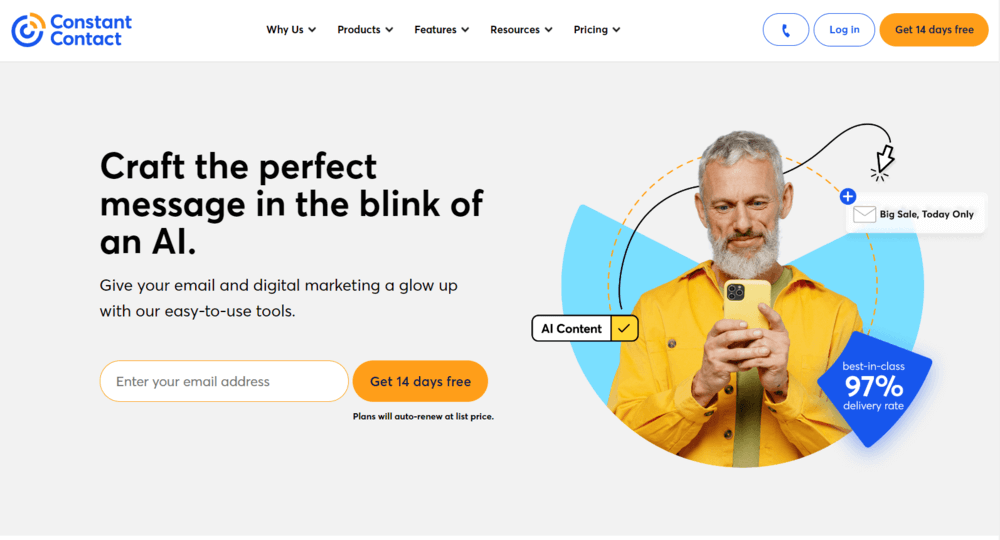
Constant Contact is an email marketing tool designed for small businesses and beginners, making it a solid GetResponse alternative. It’s great for those just starting with email marketing or event organizers. Constant Contact shines with its ease of use and good email deliverability rates.
Constant Contact Best Features
- User-Friendly Interface: Easy for beginners to navigate.
- Template Library: Over 200 email templates available.
- Email Editor: Fast, responsive, and offers drag-and-drop functionality.
- Segmentation: Efficient audience segmentation options.
- Analytics: Clear dashboard with essential email marketing metrics.
- Email Deliverability: High success rate in reaching email providers.
- Integrations: Nearly 5,500 options, including social media integrations.
Regarding its performance, Constant Contact provides a user-friendly experience with a clean interface and helpful tips within it.
The template library, while vast, does have some outdated designs. The email editor is quick, responsive, and supports basic personalization. Segmentation is a breeze, allowing for effective audience targeting.
Analytics are straightforward, though they lack advanced insights. The platform ensures high email deliverability, a key factor in successful email marketing.
Constact Contact Pros and Cons
Pros:
- Easy to use: Ideal for beginners or small businesses.
- Good Template Selection: Offers a variety of choices.
- Strong Segmentation: Helps target specific audience groups.
- Impressive Integration Options: Connects with many other tools.
- Reliable Deliverability: Emails reach recipients effectively.
Cons:
- Limited Automation Features: Not as advanced as some competitors.
- Basic Analytics: Lacks depth in reporting.
- Some Outdated Templates: Affects the modern feel of campaigns.
- No Free Version: Unlike some GetResponse alternatives.
Constant Contact Pricing
Pricing details of Constant Contact are crucial when considering it among GetResponse alternatives. The Lite plan starts at $12 per month for up to 500 contacts. The Standard plan, offering more features, starts at $35. There’s also a Premium plan at $80 per month, catering to larger needs with unlimited user accounts and more advanced features.
Special discounts are available for longer commitments and non-profit organizations. Plus, you can take advantage of a 30-day or 60-day free trial, depending on your location, to test out the service before committing. This makes Constant Contact a flexible and potentially cost-effective choice.
3. Moosend
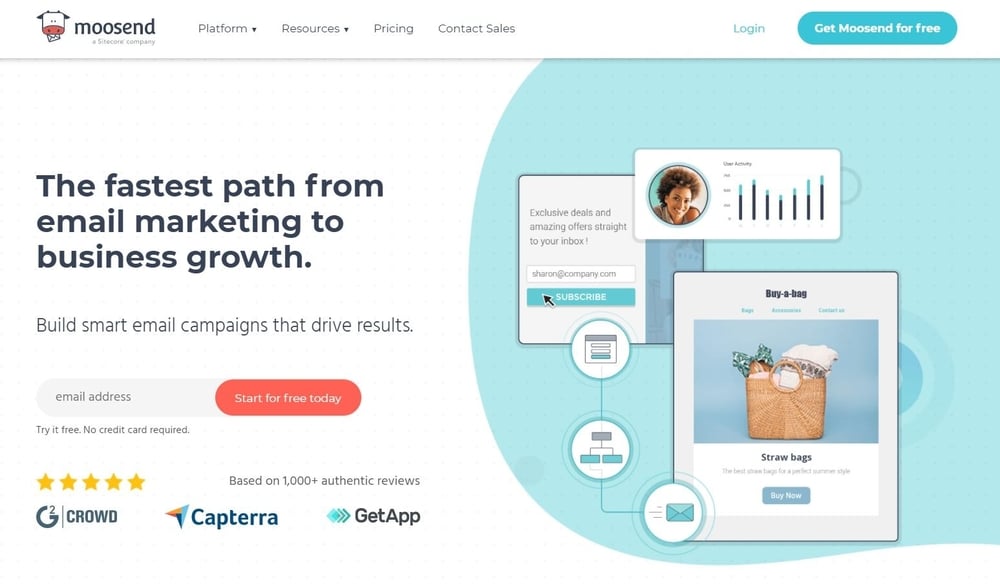
Moosend is an email marketing service that’s grabbing attention in the online world. It’s a popular choice among businesses, especially as one of the GetResponse alternatives. Moosend stands out for its comprehensive features, catering to a wide range of email marketing needs.
This platform is all about making email marketing straightforward and effective. From creating email campaigns to managing subscriber lists, Moosend has got it covered.
Their Pro plan, which I explored, runs smoothly, allowing for a range of email campaign types like regular, A/B split, and RSS campaigns. The ease of use is a big plus, particularly for those new to email marketing.
One of the cool things about Moosend is its email template editor. It’s simple but powerful, offering over 70 templates. Plus, their templates are mobile-friendly – a must in today’s smartphone-dominated world.
The platform also offers personalization options, making your emails feel more individual to each subscriber.
It stands out for its ease of use and variety of features.
Moosend Best Features
- Unlimited Email Campaigns: No limit on the number of emails you can send.
- Diverse Email Campaign Types: Includes regular, A/B split, repeatable HTML, and RSS campaigns.
- Over 70 Email Templates: A wide range of templates for different needs.
- Simple Email Template Editor: Easy-to-use for crafting your emails.
- Image and GIF Integration: Import images and GIFs from various sources, including Unsplash and Giphy.
- Segmentation Tools: Helps in organizing subscribers based on specific criteria.
- List Hygiene Features: Keeps your subscriber list clean and engaged.
- Mobile-Friendly Templates: Ensures your emails look great on all devices.
- A/B Testing: Test different elements of your email campaigns.
- Automation Capabilities: Automate email campaigns based on subscriber activities.
- Landing Page Creation: Over 30 templates for creating landing pages.
- Third-Party Integrations: Connects with platforms like Mailchimp, Zapier, WordPress, etc.
In addition to these features, Moosend also boasts strong deliverability, ensuring your emails actually reach your audience. Its deliverability measures, like DKIM authentication, help to prevent emails from landing in the spam folder. This is crucial in email marketing, as you want your messages to be seen and read.
However, no service is perfect, and Moosend has some downsides. One area where it falls short is customer support. The experience can be hit or miss, which might be a concern if you need help fast. Also, there’s no support for right-to-left (RTL) languages, which could be a limitation for some users.
Moosend Pros and Cons
Pros:
- Comprehensive Feature Set: Moosend offers almost everything you need for effective email marketing.
- Easy-to-Use Interface: Great for beginners and professionals alike.
- Solid Automation: Advanced automation options that are easy to set up.
- Good Template Selection: A diverse range of email templates.
- Strong Email Deliverability: Features like DKIM enhance the chances of your emails being properly delivered.
Cons:
- Limited Customer Service: Some issues with responsiveness and quality of support.
- No RTL Language Support: Right-to-left languages like Hebrew and Arabic are not supported.
- Limited Font Selection: A small range of fonts, mainly system fonts.
- No Affiliate Marketing: Moosend doesn’t allow affiliate marketing on its platform.
Moosend Pricing
Pricing is always a big factor, and Moosend does well here.
They offer a free plan, which is great for starting out, and it includes most of the essential features. The Pro plan starts at around $7 per month (if paid annually) for up to 500 subscribers, which is reasonable. Remember, there are no refunds, so it’s worth trying the free plan first to see if it suits your needs.
Moosend makes managing email marketing easier and could be a smart choice if you’re looking for GetResponse alternatives.
4. tinyEmail
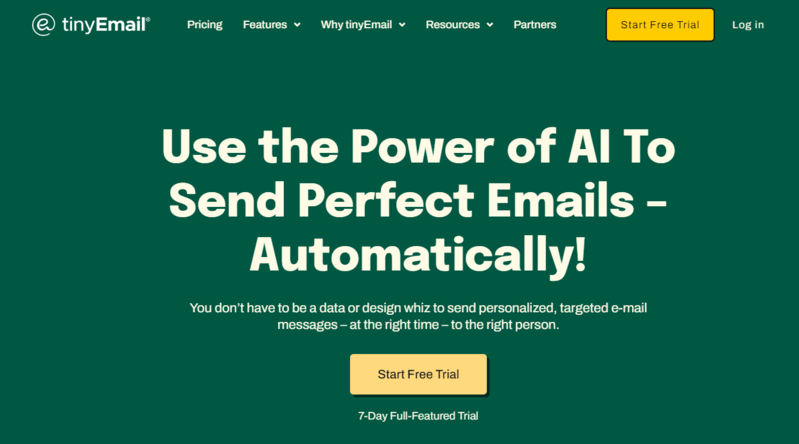
tinyEmail is a modern email marketing tool designed for small and medium-sized businesses, bloggers, podcasters, and eCommerce enterprises. It stands out as a smart choice among GetResponse alternatives, thanks to its AI-driven features.
One of tinyEmail’s main attractions is its Artificial Intelligence (AI) capabilities, which streamline and enhance your email marketing efforts. It’s not just another email tool; it’s an intelligent platform. The AI helps in pulling relevant brand aesthetics and content automatically, a feature particularly handy for those new to email marketing or with limited time. This AI integration is a big plus when compared to traditional tools like GetResponse.
The platform’s user-friendly interface and efficient automation make it a hit. The drag-and-drop email editor, customizable templates, and advanced analytics simplify the process of creating and tracking emails. These features are perfect for you if you’re looking for an email marketing solution that’s easy to use yet powerful.
tinyEmail’s advanced segmentation allows you to target your emails precisely, increasing engagement and conversion rates. Plus, its affordability makes it a great option if you’re budget-conscious.
tinyEmail Best Features
- AI-Powered Tools: Automates and enhances email campaigns.
- User-Friendly Interface: Easy for beginners.
- Customizable Email Templates: Tailor your emails to fit your brand.
- Drag-and-Drop Editor: Simplifies email creation.
- Advanced Analytics: Track your email campaign’s success.
- Advanced Segmentation: Target specific audience groups.
- A/B Testing: Optimize your email campaigns.
- Affordable Pricing: Budget-friendly plans.
tinyEmail is perfect for you if you’re looking for a tool that’s easy to use but also packs a punch with advanced features. Its AI capabilities set it apart from many GetResponse alternatives, helping you to quickly start and optimize your email campaigns. The automation features save time, letting you focus on other aspects of your business or content creation.
tinyEmail Pros and Cons
Pros:
- AI Integration: Saves time and enhances campaign quality.
- Ease of Use: Great for beginners.
- Affordable Plans: Suitable for small businesses.
- Free Tier Available: Up to 25,000 sends for smaller email lists.
- Ecommerce Integrations: Works with platforms like Shopify.
Cons:
- Limited Customer Support: May be an issue outside business hours.
- Less Advanced Segmentation: Compared to some competitors.
- Newer in Market: Less established than some alternatives.
- Limited Integrations: Still expanding its offerings.
tinyEmail Pricing
tinyEmail’s pricing starts from as low as $15/month for the Standard plan, making it a cost-effective choice. If you need more advanced features, the Pro plan is available for $65/month.
For large-scale needs, there’s a customizable Enterprise plan. There’s also a completely free tier, ideal if you’re just starting out or have a smaller email list.
In summary, tinyEmail is a robust, AI-driven email marketing tool that’s a great alternative to GetResponse, especially if you’re looking for an easy-to-use, affordable solution. Whether you’re a small business owner, a content creator, or run an eCommerce site, tinyEmail has features that can cater to your needs.
5. Mailchimp
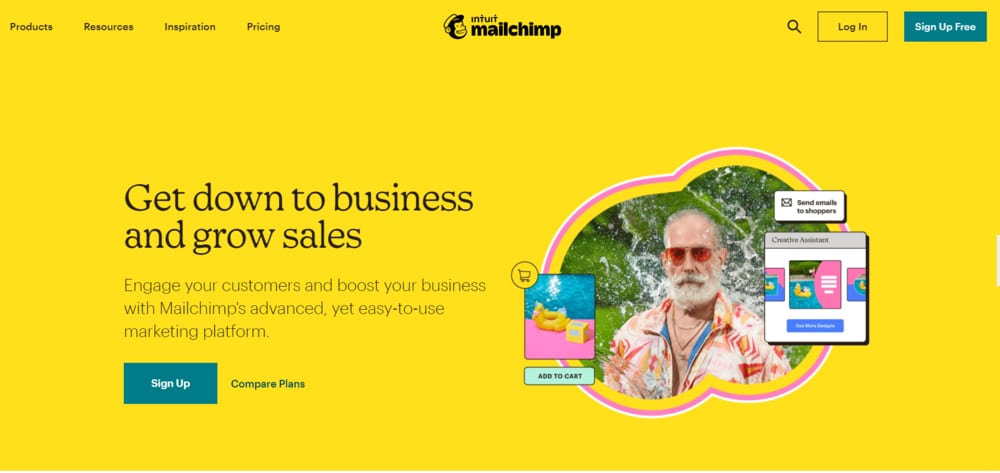
Mailchimp is a widely recognized email marketing platform, and it’s especially popular for its user-friendly design and comprehensive features. This platform is a go-to choice for many, from individuals to small businesses, thanks to its versatility and ease of use.
As of now, Mailchimp boasts an impressive user base with over 14,000 new sign-ups daily. Its popularity is further reflected in its recent acquisition by Intuit for a staggering $12 billion, indicating its significant value in the market.
One of the standout aspects of Mailchimp is its free plan, which attracts many users. This plan, although recently scaled down, still offers access to a majority of Mailchimp’s tools, including survey makers and landing page builders.
The free plan currently allows for a maximum of 500 contacts, a decrease from the previous 2,000. While the free plan includes several useful features, it excludes automations, which are pivotal for advanced email marketing strategies.
Mailchimp isn’t just about sending emails; it’s a comprehensive marketing tool. Users appreciate its clean interface and powerful template editor, making it easy to create professional-looking emails. The platform offers thorough reporting capabilities, integrating with services like Google Analytics and social media for insightful analytics.
Moreover, with over 500 integrations, Mailchimp seamlessly works alongside various other marketing tools.
Mailchimp Best Features
- Free Plan Accessibility: Includes most tools, suitable for personal and small business use.
- Template Editor: Easy to use with a range of options for customization.
- Comprehensive Reporting: In-depth analytics with integration options.
- Integration Options: Over 500 integrations available, enhancing marketing flexibility.
- Additional Features: Includes appointment scheduling software and an online store builder.
Mailchimp scores highly for its ease of use.
The platform has a user-friendly interface, though some users find navigation a bit tricky at first. The initial setup process can be somewhat challenging, but overall, the platform is designed for accessibility.
Mailchimp’s deliverability has been a point of contention in the past, but recent improvements have seen it perform better in this area. However, alternatives like Moosend are often recommended for superior deliverability.
Mailchimp Pros and Cons
Pros:
- User-Friendly Interface: Easy for beginners to navigate and use.
- Robust Reporting: Detailed analytics and integration with other platforms.
- Diverse Integrations: Compatible with a wide range of other tools and services.
- Advanced Features: Beyond basic email, includes CRM and e-commerce tools.
Cons:
- Limited Free Plan: Recent changes have reduced the number of contacts and features available for free.
- Complexity in Navigation: Some users find the interface and setup process a bit confusing.
- Deliverability Issues: Although improving, Mailchimp’s email deliverability has been questioned.
Finally, let’s talk about pricing.
Mailchimp Pricing
Mailchimp offers several plans, tailored to different needs and budgets. The free plan is quite limited but a good starting point. Paid plans start at $45 per month for 2,500 subscribers and go up to $300 for 30,000 subscribers.
While Mailchimp can be a bit pricey, its range of features and ease of use make it a strong contender in the market.
6. Campaign Monitor
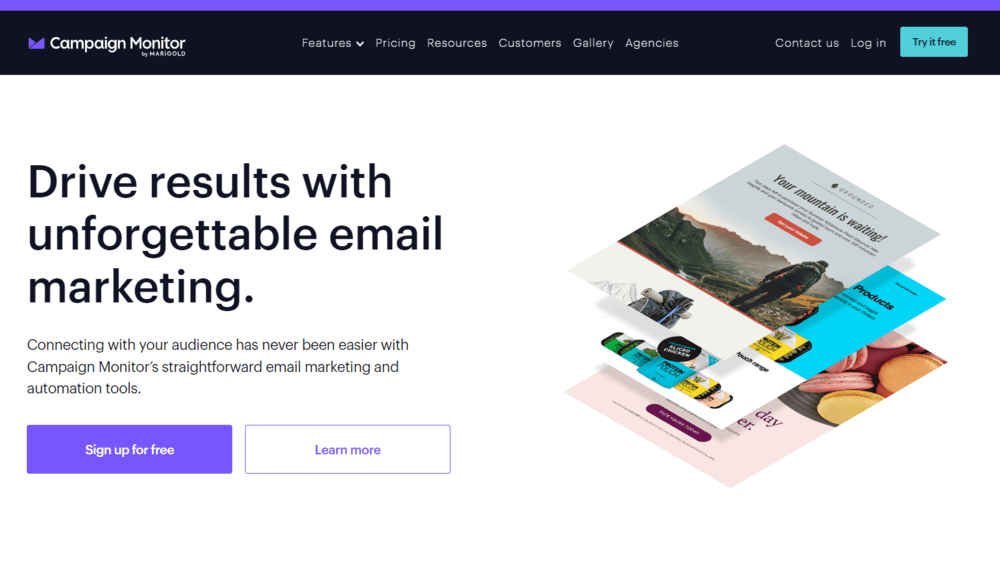
Campaign Monitor is another popular email marketing tool used by many businesses around the world. Over 250,000 businesses have chosen Campaign Monitor for their email marketing needs. This shows how popular and trusted it is in the industry.
Campaign Monitor stands out for its user-friendly web app, allowing you to manage mailing lists, create HTML e-newsletters, and automate your email marketing with ease. It’s a ‘software as a service’ tool, meaning it’s available for a monthly fee rather than a one-time purchase.
What makes Campaign Monitor appealing is its ease of use and the range of features it offers. Whether you’re sending mass mailouts, setting up autoresponders, or analyzing the results of your email campaigns, it has you covered. Additionally, it now supports marketing automation, making it a versatile tool for diverse email marketing strategies.
Campaign Monitor Best Features
- Mass Mailouts: Send emails to a large number of recipients easily.
- Autoresponders: Automate email responses based on user actions.
- Marketing Automation: Enhance your marketing strategy with automated processes.
- Analysis Tools: Track and analyze the performance of your email campaigns.
- Template Library: Access a wide range of templates for your emails.
- Drag and Drop Email Builder: Easily create emails with a user-friendly interface.
- Support Options: Get assistance through email support and, on higher plans, phone support.
- Flexible Pricing Plans: Choose from ‘Lite’, ‘Essentials’, or ‘Premier’ plans to fit your needs.
Campaign Monitor is particularly noted for its user-friendly interface, which is straightforward and clutter-free. This is great for people who are new to email marketing. The platform’s templates are another strong point. They are not only attractive but also responsive, meaning they adjust well to any device, whether it’s a mobile phone, tablet, or desktop computer.
Campaign Monitor Pros and Cons
Pros:
- Easy to Use: The interface is user-friendly, perfect for beginners.
- High-Quality Templates: Beautiful, responsive templates that work across devices.
- Effective Segmentation: Easily segment your data for targeted marketing.
- Comprehensive Automation Features: Powerful tools for setting up automated emails.
- Multiple Plan Options: Flexibility to choose a plan that suits your needs and budget.
Cons:
- Costly: More expensive compared to many competitors.
- Limited Split Testing: Only two variants can be tested at a time.
- No Free Trial: Lacks a comprehensive free trial option.
- Limited Landing Page Creator: Not as advanced as some alternatives.
- Basic RSS-to-Email Tool: Less flexibility in this area.
Campaign Monitor Pricing
Campaign Monitor offers three main plans: ‘Lite’, ‘Essentials’, and ‘Premier’. The pricing depends on the size of your email list. For instance, for a list of 500 email addresses, the ‘Lite’ plan is $11 per month, ‘Essentials’ is $19 per month, and ‘Premier’ is $149 per month. As the number of email addresses in your list increases, so does the price.
When considering GetResponse alternatives, Campaign Monitor stands out for its simplicity, beautiful templates, and comprehensive features. However, keep in mind the higher cost and the limitations in some of its features, like split testing and the RSS-to-email tool.
7. Sendpulse
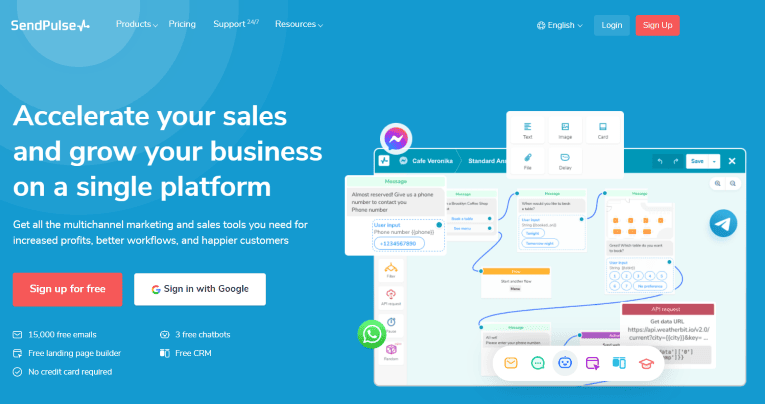
SendPulse is another exciting tool that stands out among GetResponse alternatives. It’s a multichannel marketing automation system, which means it helps you manage and send out marketing messages through various channels. Not just emails, but also SMS and push notifications.
With a user-friendly interface, SendPulse is perfect for both seasoned marketers and beginners. It’s smart, too – it adjusts based on your marketing experience. This personalization is a big plus!
SendPulse Best Features
- Tailored Setup: Adapts to your experience level for an easier start.
- Advanced Email Campaigns: Personalize emails for better engagement.
- Segmentation Options: Target your audience more accurately.
- A/B Testing: Test and choose the best email versions.
- Workflow Automation: Automatically send emails based on user actions.
- Variety of Signup Forms: Create different forms to grow your email list.
- Contact Management: Easily manage and segment your contacts.
- 24/7 Support: Always available help, including a live chat option.
SendPulse Pros and Cons
Pros:
- Customizable Setup: It’s great for all levels of experience.
- Form Building: Create forms that suit your needs.
- Detailed Segmentation: This helps send relevant messages.
- Support Options: Access to 24/7 help is super handy.
Cons:
- Complex Interface: Might be overwhelming at first.
- Limited Email Scheduling: Fewer options than some other tools.
- Pricing Structure: It might not suit everyone’s budget.
SendPulse Pricing
When it comes to pricing, SendPulse is quite flexible.
They offer a free plan for up to 500 subscribers and 15,000 emails. This plan is great if you’re just starting. For more features, there are paid plans that vary based on the number of subscribers. Plus, you can save money with a 10% discount for six months’ advance payment or 30% for a full year.
There’s also a pay-as-you-go option, which is perfect if you don’t send emails often.
So, if you’re looking for GetResponse alternatives, SendPulse is a strong contender with its range of features and user-friendly design. Whether you’re new to email marketing or a pro, it’s got something for you!
8. Drip

Drip is an email marketing platform that’s been making waves, especially for those in the eCommerce world. Born in 2013, Drip quickly evolved from a simple email widget to a full-blown marketing automation tool.
After being acquired by Leadpages in 2016, Drip’s focus on eCommerce marketing and Customer Relationship Management (CRM) has become its defining trait. While it’s mainly tailored for eCommerce marketers, service-based businesses can also find value in its features.
What sets Drip apart is its blend of simplicity and power. Its Visual Email Builder lets you create stunning emails without needing to know coding, and the platform offers over 50 email templates.
Drip’s advanced automation, with options like Workflows and Rules, saves time and boosts efficiency.
It also shines in segmentation and personalization, ensuring your emails hit the right note with your audience.
Drip Best Features
- Visual Email Builder: Drag-and-drop functionality for easy email creation.
- 50+ Email Templates: Choose from a variety of designs.
- Advanced Automation: Workflows and Rules for efficient email marketing.
- Mailing Lists and Segmentation: Tailor your emails for specific audience groups.
- A/B Testing: Optimize your emails for better engagement.
- Form Builder: Capture leads effectively on your site.
- Built-In Reporting: In-depth analysis of your marketing campaigns.
- 100+ Integrations: Works with a range of eCommerce platforms and tools.
Drip isn’t just another tool; it’s a robust platform that integrates seamlessly with many eCommerce platforms like Shopify, WooCommerce, and Magento. This means you can manage customer interactions smoothly across different channels. Plus, its user-friendly interface makes it a hit among those who might be new to email marketing.
Drip Pros and Cons
Pros:
- Flexible Tagging: Enhance subscriber segmentation.
- Top-tier Automation: Advanced workflows for better email marketing.
- User-Friendly Interface: Easy to navigate and use.
- eCommerce Integrations: Works well with major eCommerce platforms.
- Advanced Reporting: Deep insights into campaigns and customer behavior.
- Numerous Integrations: Over 100 integrations expand its functionality.
Cons:
- Premium Pricing: More expensive than some GetResponse alternatives.
- Limited A/B Testing: Can’t test email content or full automation workflows.
- Form Builder Limitations: Basic compared to some competitors.
- Complicated Pricing Tiers: Can be confusing as your list grows.
- Basic Email Templates: Might not suit those looking for more design depth.
- Support Limitations: Relies more on knowledge base and email support.
Drip Pricing
For pricing, Drip starts at $39 per month for up to 2,500 subscribers. The pricing scales with the number of subscribers, with the next tier at $49 for up to 3,000 subscribers. While the pricing structure is straightforward, it’s worth noting that it can get pricey as your list grows.
However, for the features and integrations it offers, Drip could be a solid investment, especially if you’re in eCommerce. They also offer a 14-day free trial, which is great for testing the waters.
Overall, Drip stands out for its eCommerce focus and robust feature set. If you’re looking for a tool that goes beyond basic email marketing, Drip could be the choice for you.
9. Mailerlite
MailerLite is an impressive email marketing tool that’s perfect if you’re looking for GetResponse alternatives. It’s not just about sending emails; MailerLite offers a suite of features to grow your online presence and engage with your audience effectively.
As of now, MailerLite is used by thousands of users worldwide, a testament to its reliability and effectiveness.
It’s widely recognized for its user-friendly interface and affordability, making it a go-to choice for bloggers, small businesses, and anyone preferring a straightforward email tool.
MailerLite Best Features
- Email Campaigns: Easy to create and send newsletters, promotions, and automated digests from blog content.
- A/B Split Testing: Optimize your emails by testing different elements.
- Audience Growth Tools: Use forms and pop-ups to increase your subscriber list.
- Segmentation: Organize your subscribers based on their behavior and preferences.
- Website and Landing Page Building: Not just for emails, also create landing pages and websites.
- Marketing Automation: Set up automatic emails for efficient communication.
- Excellent Support: 24/7 live chat support for all your queries.
Now, let’s talk about the pros and cons of using MailerLite.
MailerLite Pros and Cons
Pros:
- Cost-Effective: Provides great value for your money.
- User-Friendly: Easy to navigate and use, even for beginners.
- Versatile Features: From email campaigns to landing pages, it’s all there.
- Strong Automation Tools: Automate your emails effectively and save time.
- Reliable Support: Quick and helpful customer service.
Cons:
- Limited Triggers in Automation: Doesn’t trigger from website visits.
- Basic Templates: Though functional, more variety could be better.
MailerLite Pricing
In terms of pricing, MailerLite is very budget-friendly, especially when compared to its competitors. The free plan covers up to 1,000 subscribers and 12,000 emails per month, which is fantastic for beginners.
Paid plans offer more features and higher limits, and they are still quite affordable. The cost increases based on the number of subscribers, so you can scale as your audience grows.
When looking for GetResponse alternatives, MailerLite stands out due to its simplicity, cost-effectiveness, and range of features. It suits those just starting out, as well as those who need more advanced capabilities but still want an easy-to-use interface.
With MailerLite, you can manage your email marketing, create landing pages, and engage with your audience without the need for multiple tools. It’s a comprehensive solution that balances functionality with user-friendliness.
10. Omnisend
Omnisend is a comprehensive ecommerce marketing automation tool designed to streamline your online marketing efforts.
It’s particularly effective for online stores of various sizes and caters to a diverse range of industries.
With its focus on personalization, Omnisend enables you to send the right message at the right time through the right channel, ensuring your marketing is as effective as possible.
Omnisend Best Features
- User-friendly Interface: Quick signup and easy onboarding.
- Competitive Pricing: Cost-effective plans, potential savings up to 50%.
- Premium Automation: Advanced, no-code automation editor.
- Product Picker: Easily add products to newsletters.
- Centralized Platform: Combines multiple channels like social media and SMS.
- One-Click Integrations: Supports over 30 popular apps.
- Easy Software Migration: Smooth transition with data sync.
- Excellent Customer Support: Real-time human assistance.
I find Omnisend’s approach to marketing automation remarkable. It combines email, SMS, and web push notifications in one workflow, ensuring consistency across various platforms. This not only saves time but also enhances the customer experience.
Additionally, its pre-built workflows for scenarios like cart abandonment and order confirmations simplify the process, making it easier for you to focus on other aspects of your business.
Omnisend Pros and Cons
Pros:
- Simplifies marketing across multiple channels.
- Saves time with pre-built workflows and automation.
- Increases engagement with personalized messages.
- Enhances email campaigns with the Product Picker feature.
Cons:
- Limited communication on updates, causing user confusion.
- Noticeable price increase between Standard and Pro plans.
Omnisend Pricing
- Free Plan: Ideal for beginners, includes basic features.
- Standard Plan: Starts at $16/month for up to 500 contacts, includes automation and 24/7 support.
- Pro Plan: Starts at $59/month, offers omnichannel marketing tools and advanced reporting.
As a GetResponse alternative, Omnisend stands out for its focus on ecommerce and multichannel marketing. While GetResponse is a versatile tool for email marketing and automation, Omnisend provides a more specialized service for ecommerce businesses.
Its intuitive design, competitive pricing, and robust automation capabilities make it an excellent choice.
